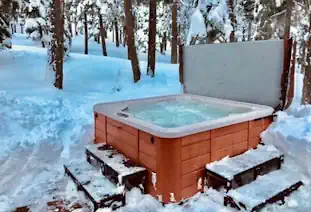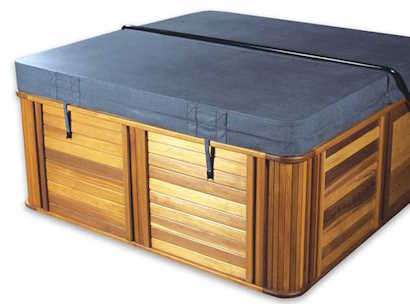“Exploring Hot Tub Types: A Comprehensive Guide for Homeowners and Wellness Enthusiasts”

There’s nothing quite like the warm, swirling waters of a hot tub to ease away the stresses of the day. As the popularity of hot tubs continues to rise among homeowners and wellness enthusiasts, the market is flooded with an array of options.
From the affordable and convenient inflatable hot tubs to high-end, feature-rich acrylic spas, choosing the right one for your lifestyle and space can be a relaxing yet rewarding challenge.
Types of Hot Tubs
When it comes to selecting the perfect hot tub, understanding the different types available can help you make an informed decision. Here’s a list of the various hot tubs you might consider:
- Inflatable Hot Tubs: Easily portable and budget-friendly, inflatable hot tubs are ideal for those who want the luxury of a spa without a permanent commitment.
- Rotomolded Hot Tubs: Constructed from a single piece of plastic, these are lightweight and typically more affordable than other permanent spas.
- Portable Hot Tubs: Combining convenience with comfort, portable hot tubs are perfect for those who seek mobility and the freedom to set up a relaxing spa experience in various locations, whether indoors or outdoors. They typically offer a plug-and-play setup and are a great choice for renters or those who frequently move.
- Acrylic Hot Tubs: Offering durability and a plethora of design options, acrylic hot tubs are the standard for permanent, high-quality spas.
- Wooden Hot Tubs: A nod to traditional craftsmanship, wooden hot tubs blend aesthetics and functionality, often used in rustic or naturalistic settings.
- Stainless Steel Hot Tubs: Known for their sleek look and durability, stainless steel hot tubs are resistant to corrosion and offer a modern twist to the spa experience.
- Saltwater Hot Tubs: Utilizing a saltwater system for sanitation, these hot tubs can be gentler on the skin and eyes, and require less chemical maintenance.
Each type has its own set of pros and cons, and the right choice depends on your preferences, maintenance commitment, and budget.
Inflatable Hot Tubs: The Easy-Setup Choices
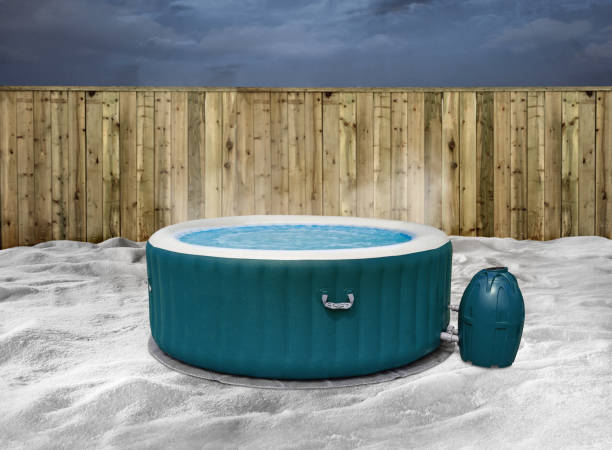
Before you think of a spa as a permanent fixture, consider the allure of inflatable hot tubs. Imagine the joy of soaking in a bubbling oasis, all attuned to your personal well-being, without the constraints of space or a hefty price tag. Here’s why an inflatable hot tub might just be the buoyant starter for your water wellness needs.
The Air-Up Option: Pros and Cons of Inflatable Hot Tubs
Inflatable hot tubs are the epitome of comfort and convenience. They are designed for quick setup and can be deflated and stored when not in use. This makes them perfect for those who aren’t ready to commit to a permanent spa installation or who have limited outdoor space. However, they do come with a size limit and may not be the most durable option for year-round use.
Recommended Inflatable Hot Tub Brands and Models
For high-quality inflatable hot tubs, reputable brand options like Intex, Coleman, and Bestway are favorites among users. These brands offer models with durable materials, efficient heating systems, and a range of jets to provide a custom hydrotherapy experience.
Rotomolded Hot Tubs: The Durable and Affordable Spa Solution
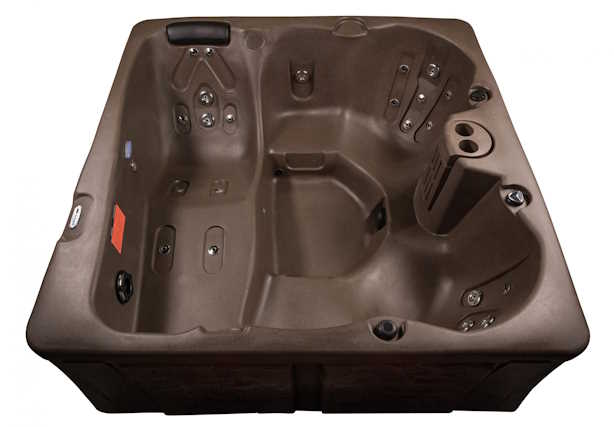
Rotomolded hot tubs, also known as rotationally molded hot tubs, are an excellent middle-ground choice for those seeking durability without the heavyweight price tag that often comes with more permanent structures. These hot tubs are crafted from a single piece of high-density plastic, seamlessly constructed to avoid leaks and cracks that can occur in other types of spas.
The Appeal of Rotomolded Hot Tubs
Rotomolded hot tubs offer several advantages. Their one-piece construction guarantees a durable product less prone to damage over time. They’re lighter than traditional acrylic spas, making them easier to relocate if necessary. Furthermore, these hot tubs tend to be more cost-effective both in initial purchase and maintenance costs, providing a budget-friendly option that still offers a luxurious spa experience. They should not be considered as plastic hot tubs. The construction and durability of a these hot tubs is on par with any standard hot tub.
Top Picks for Rotomolded Hot Tubs
When shopping for a rotomolded hot tub, models from Nordic Hot Tubs and Dream Maker Spas come highly recommended. Known for their sturdiness and modern designs, these brands deliver an array of features, such as customizable jets and energy-efficient heating systems, to enhance your soaking sessions while keeping the overall costs manageable.
Portable Hot Tubs: The Middle Ground
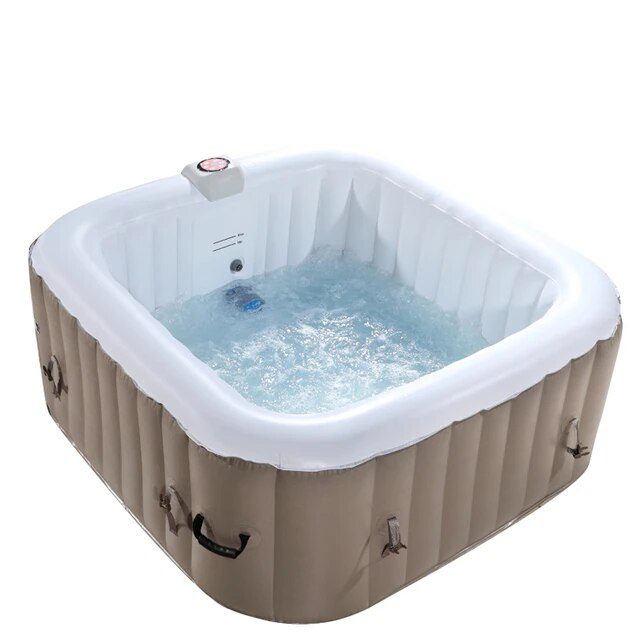
Step up your relaxation game without stepping up your stress levels with portable hot tubs. These sturdy yet moveable tubs offer a compromise between inflatable hot tubs and more permanent fixtures like an in ground hot tub. Here’s why they might be the perfect solution for those who want a quality hydrotherapy experience with added flexibility.
The Strength of Portability: Pros and Cons of Portable Hot Tubs
Portable hot tubs offer more durability and insulation than inflatables. They often come with more features such as LED lighting and Bluetooth sound systems, yet they remain easy to set up and relocate. The cost of these features is their size – they’re larger than inflatable tubs and may not be as easily stored.
Recommended Portable Hot Tub Brands and Models
For those looking to invest in a portable spa, brands like Lay-Z-Spa, Essential Hot Tubs, and LifeSmart offer a range of models with durable construction, energy-efficient designs, and a variety of seating configurations for comfort and socializing.
Acrylic Hot Tubs: The Traditional Choice

For those who yearn for the full spa experience and are ready to commit space and resources, acrylic hot tubs remain the quintessential choice. These luxurious fixtures promise the most extensive array of features and customization options. Here’s why they are the benchmark for many spa connoisseurs.
The Pinnacle of Comfort: Pros and Cons of Acrylic Hot Tubs
Acrylic hot tubs are known for their extensive variety of jets, seating configurations, and advanced control systems. They offer the best durability and insulation, often withstanding harsh weather conditions. However, this comes at a cost — both in terms of the initial investment and operational expenses.
Recommended Acrylic Hot Tub Brands and Models
Leading the charge in the acrylic hot tub market are brands like Jacuzzi, Hot Spring, and Bullfrog Spas, offering models with innovative features like waterfalls, ergonomic seating, and multi-layer insulation for maximum relaxation and convenience.
We personally own a Bullfrog Spa hot tub with the interchangeable jet packs. Super easy to adjust the location and intensity of the jet packs. We definitely enjoy our Bull Frog.
Wooden Hot Tubs: The Rustic Retreats

For those who long for a hot tub experience that harkens back to nature, wooden hot tubs are a rustic and aesthetically pleasing choice. Crafted from beautiful materials, these tubs offer a unique ambiance and some unexpected benefits to top it off. Here’s why they might be the mindful choice for your outdoor oasis.
The Charm of Tradition: Pros and Cons of Wooden Hot Tubs
Wooden hot tubs are typically made from cedar or redwood, adding an earthy, natural aesthetic to any space. They are renowned for retaining heat well and requiring minimal maintenance. However, they are generally less customizable in terms of features and seating than acrylic models.
Recommended Wooden Hot Tub Brands and Models
For the eco-conscious consumer looking for an authentic spa experience, brands like Canadian Spa Company and Almost Heaven Saunas offer high-quality wooden hot tubs that are sure to create a serene, outdoor retreat.
Stainless Steel Hot Tubs: The Contemporary Marvel
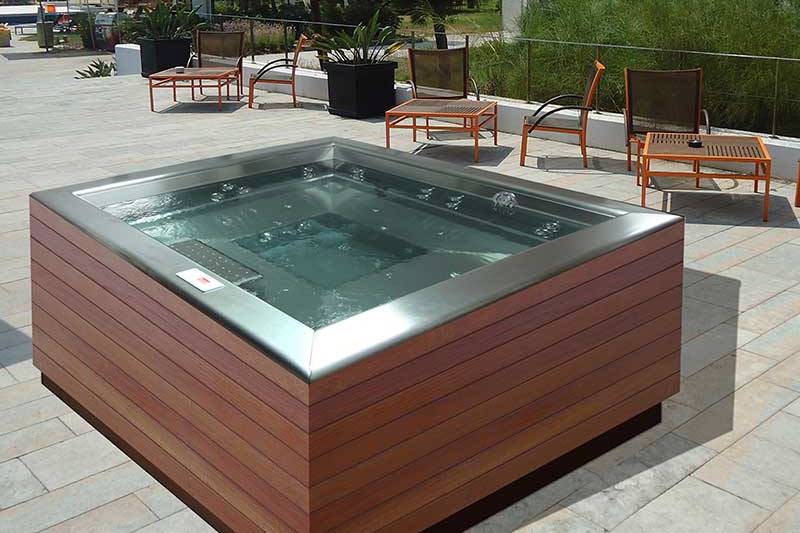
Stainless steel hot tubs exemplify modern design and innovation in spa technology. Combining elegance with functionality, they provide a sleek look that is as durable as it is stylish. Ideal for both indoor and outdoor settings, stainless steel hot tubs offer a resilient solution to those who desire longevity without compromising on luxury.
The Fusion of Style and Durability: Pros and Cons of Stainless Steel Hot Tubs
Stainless steel hot tubs boast numerous advantages, including resistance to corrosion and staining, which keeps maintenance low and reliability high. Their reflective surfaces can complement sophisticated, contemporary landscapes or interiors. On the downside, the initial cost can be higher than other materials, but their durability often means a greater return on investment in the long run.
Recommended Stainless Steel Hot Tub Brands and Models
For homeowners and commercial clients seeking the best in stainless steel hot tubs, brands like Bradford Products and Diamond Spas stand out. These manufacturers are known for their craftsmanship and ability to customize tubs to fit specific design needs. Their product lines often feature cutting-edge hydrotherapy systems and eco-friendly heating options that elevate the hot tub experience to new levels.
Saltwater Hot Tubs: The Therapeutic Harmony

Saltwater hot tubs are emerging as a popular alternative offering a natural approach to spa therapy. They use a salt chlorinator system to naturally produce chlorine, which creates a softer, more soothing water experience that’s gentle on the skin and eyes. Here’s why opting for a saltwater system could be your serene sanctuary.
The Serenity of Salt: Pros and Cons of Saltwater Hot Tubs
Saltwater hot tubs provide a series of health and maintenance benefits; the natural chlorination process reduces the need for added chemicals, which appeals to health-conscious users. The water feels silkier, and the reduced chlorine levels often mean less irritation for sensitive skin. However, these systems may come with a higher upfront cost and require specific types of salt to function correctly.
Recommended Saltwater Hot Tub Brands and Models
For those interested in a spa that harmonizes wellness with convenience, brands like Hot Spring and Caldera Spas offer exceptional saltwater-friendly models. These hot tubs are engineered to enhance user comfort and provide the full therapeutic benefits of saltwater with features designed to simplify maintenance and care.
Health Benefits of Hot Tubs: More Than Just a Luxury
The allure of hot tubs isn’t just about relaxation; it’s about the multitude of health benefits they can provide. From soothing muscle and joint pain to promoting better sleep, hot tubs have become an integral part of wellness regimens for many. Here’s a look at the science behind soaking and the conditions it can help.
Easing Aches and Pains
The warm water and massaging action of hot tub jets can provide relief for a variety of bodily discomforts, including arthritis, fibromyalgia, and post-exercise soreness. The buoyancy of the water also helps to reduce pressure on joints and muscles, allowing for a more comfortable and effective recovery. The hydrotherapy jets or massaging jets of traditional hot tubs can do amazing things for tight muscles.
Stress Reduction and Mental Wellness
Immersing in a hot tub can also lower stress levels, promoting a sense of calm and well-being. The combination of warm water and massage helps to release endorphins, the body’s natural feel-good chemicals, while the serene setting can create a meditative environment that soothes the mind.
Enhancing Sleep
Many hot tub users report an improvement in the quality of their sleep after regular soaking sessions. This is due to the relaxation and stress relief hot tubs offer, as well as the physical changes the body undergoes post-soak that can induce a restful night’s sleep.
Key Considerations When Choosing a Hot Tub
Selecting the perfect hot tub for your home or business is more than just picking out a model; it requires careful consideration of several factors to ensure that your investment brings maximum enjoyment and aligns with your lifestyle. Here are essential considerations to take into account:
1. Size and Seating Capacity
- Evaluate your available space: Measure the area where you will install the hot tub to determine the maximum size you can accommodate.
- Consider the number of users: Think about how many people will typically use the hot tub at once to decide on the appropriate seating capacity.
2. Material and Construction
- Choose the right material: Between acrylic, wood, and stainless steel, decide based on durability, maintenance, and aesthetics to match your preference.
- Check the construction quality: Ensure the structure is well-built and comes with a good insulation system to maintain energy efficiency.
3. Features and Customization
- Determine must-have features: List features like jet types, seating arrangements, and lighting that are important for your relaxation experience.
- Look for customization options: Some brands offer options to customize the hot tub to your specific needs and desires.
4. Hydrotherapy Options
- Understand jet systems: Know the difference between air and water jets, and the therapeutic benefits each can offer.
- Assess hydrotherapy needs: Consider any health conditions or therapeutic needs that specific jet configurations can address.
5. Energy Efficiency
- Energy consumption: Look for energy-efficient models to minimize the long-term operating costs of heating and filtering your hot tub.
- Insulation: Good insulation is key to maintaining water temperature without excessive energy use.
6. Maintenance and Upkeep
- Ease of maintenance: Consider how the tub’s material and filtration system might affect the ease of keeping your hot tub clean and in good working order.
- Availability of replacement parts: Make sure replacement parts and service are readily available for the model you choose.
7. Cost and Budget
- Set a budget: Determine what you’re willing to spend and remember to account for installation and ongoing maintenance costs.
- Compare short and long-term costs: While a higher upfront cost might be daunting, it could mean lower maintenance and energy expenses over time.
8. Warranty and Support
- Look for a solid warranty: A comprehensive warranty can provide peace of mind and protect against future issues.
- Evaluate the manufacturer’s customer support: Read reviews about the brand’s customer service to ensure you’ll have support when needed.
Taking these factors into account will help you make an informed decision and select a hot tub that serves as a valuable addition to your personal wellness routine or entertainment space.
Conclusion: Finding Your Perfect Hot Tub
With so many types of hot tubs to choose from, it’s important to consider your specific needs and preferences. Whether you opt for the convenience of an inflatable, the mobility of a portable, the luxury of an acrylic, or the charm of a wooden hot tub, the benefits of owning your personal spa are endless. Take the plunge into hot tub ownership, and you’ll find yourself on the path to better health and relaxation.
In sum, your hot tub choice should be as personal as the experience you seek. Evaluate factors such as budget, space, and the level of commitment you’re ready for. But most importantly, envision the moments you’ll spend unwinding and the therapeutic benefits you aim to reap. With the right hot tub, every soak will be a well-deserved and rejuvenating escape.
Frequently Asked Questions (FAQs)
What should I consider when choosing a hot tub?
When selecting a hot tub, consider your budget, available space, desired material, maintenance requirements, and the therapeutic features you prefer. It’s also important to think about the capacity you need and the type of installation that suits your home.
Are saltwater hot tubs better than traditional chlorine hot tubs?
Saltwater hot tubs offer a more natural approach to chlorination and may be gentler on the skin and eyes. They typically require fewer chemicals, potentially meaning lower maintenance. However, they can be more costly upfront and necessitate specific types of salt.
How do I maintain a wooden hot tub?
Wooden hot tubs require regular maintenance, which includes cleaning the wood, maintaining the correct water chemistry, and occasionally treating the wood with specific oils to preserve its life and appearance.
Can hot tubs really improve sleep?
Yes, many people report improved sleep after soaking in a hot tub due to the relaxing effects of the warm water and massage jets. The drop in body temperature after you exit the hot tub can also help signal your body that it’s time to sleep.
Are hot tubs energy-efficient?
Energy efficiency in hot tubs can vary depending on the model and brand. However, many modern hot tubs are designed with energy-saving features such as high-quality insulation and efficient heating systems. Always check the specific energy ratings when shopping for a hot tub.
Is it possible to customize a stainless steel hot tub?
Absolutely, manufacturers like Bradford Products and Diamond Spas specialize in customizing stainless steel hot tubs to meet specific design requirements, including the size, shape, and jet configurations.
What is the lifespan of an inflatable hot tub?
Inflatable hot tubs generally have a shorter lifespan than their hard-sided counterparts, often ranging from 5 to 7 years, depending on the frequency of use and how well they are maintained.
Can hot tubs help with stress reduction?
Hot tubs are known to aid in stress reduction. The combination of warm water, jets, and the act of taking time to relax can significantly lower stress levels and promote a sense of well-being.
Remember to consult your hot tub manual and a professional for specific maintenance instructions and to consider your personal health needs and consult with a healthcare provider if you have any concerns.
